Now that I have explained at least a small sliver of the background to the O’Bannon v. NCAA case, I can begin the analysis of the ruling itself. Handed down by U.S. District Court Judge Claudia Wilken ’71, the document is separated into many sections, the substance of which are based on distinct discussions of law and facts deemed relevant by Wilken. I will tackle the introduction and the first few sections of the Findings of Fact in this installment of my column series on the O’Bannon case.
There are several key aspects of the introduction to Wilken’s 99-page ruling, the most important of which is delineating the class of NCAA athletes that the decision applies to, namely “elite men’s football and basketball players.” It cannot be understated that the results of the O’Bannon suit apply to a very small, albeit high-profile, highly-marketable and highly-exploitable set of collegiate athletes.
The introduction also gives the positions of both the plaintiffs (athletes) and defendant (NCAA), and, as most legal documents do, gives away the ending: “The Court finds that the challenged NCAA rules unreasonably restrain trade…and will enter as a remedy a permanent injunction prohibiting certain overly restrictive restraints.”
Interestingly, the NCAA does not deny that its rules governing student-athlete compensation are restrictive; that fact is undisputed by either side. What the NCAA does argue is that these restrictions are integral to fulfill its “educational mission and to protect the popularity of college sports.”
The implication of this argument is that if athletes are paid for their name, image and likeness (NIL), they will automatically forsake their academic interests and pursuits and, essentially, transform into professional athletes. As a result, the NCAA contends, collegiate athletics will be unable to maintain its status as one of America’s most popular and marketable sports ventures because fans are only interested in college football and basketball due to the fact that the players are unpaid amateurs.
Yeah, right.
I, of course, vehemently disagree with both of these assertions. The argument that collegiate football and basketball players would cease to fulfill their academic obligations if they were to be paid for the use of their NILs is not only overly-paternalistic, it is a scathing generalization of these and all other student-athletes. What NCAA is doing here is assuming that once athletes begin to be remunerated for their efforts on the field of play, they will forget about their responsibilities in the classroom.
In fact, the opposite may be true. Consider this: If player compensation is tied to on-field appearances, doesn’t that give an individual even more incentive to stay eligible for intercollegiate competition? In other words, if NCAA athletes are being remunerated for their efforts in the athletic arena, shouldn’t that provide them an even stronger reason to take care of their business in the academic arena and remain eligible?
If I knew my compensation was tied to my ability to maintain a certain grade point average and other academic benchmarks, I would make very sure that I was meeting all of my classroom-related responsibilities.
Secondly, the logic that the only reason collegiate athletics is popular is because of the unpaid, amateur status of its players is simply untrue. I have yet to find one person — and I have talked to and questioned many people — that states their interest in watching/viewing an NCAA football or basketball contest is due solely to the “unprofessional” nature of the athletes.
Ask yourself this question: Do I go watch a Stanford football game because I know Ty Montgomery isn’t being paid like a professional? Do I make the trek to Maples Pavilion to see the men’s basketball squad in action only because Chasson Randle is not receiving a dime for his efforts? The answer for me is an unequivocal ‘no’; if yours is different, I would like to hear your reasoning.
Another notable passage in the first few pages of Wilken’s ruling is a quote from the NCAA’s constitution, which reads in part: “[the NCAA’s goal is to] initiate…intercollegiate athletics programs to promote and develop…athletics participation as a recreational pursuit (emphasis added).”
We all know that NCAA participation, no matter the level of competition, is no simple avocation. As a student-athlete myself, I know first-hand that collegiate athletics is not just a hobby. But why is the NCAA capitalizing on the hard work of student-athletes if their efforts are supposed to be “recreational pursuits”? Riddle me that, Mark Emmert.
Cameron Miller’s feelings for the NCAA are superseded only by his “love” for the San Francisco Giants. To discuss his hot take on the NCAA, or to inform him that he is on the wrong side of the Giants-Dodgers rivalry, e-mail him at cmiller6 ‘at’ stanford.edu.
